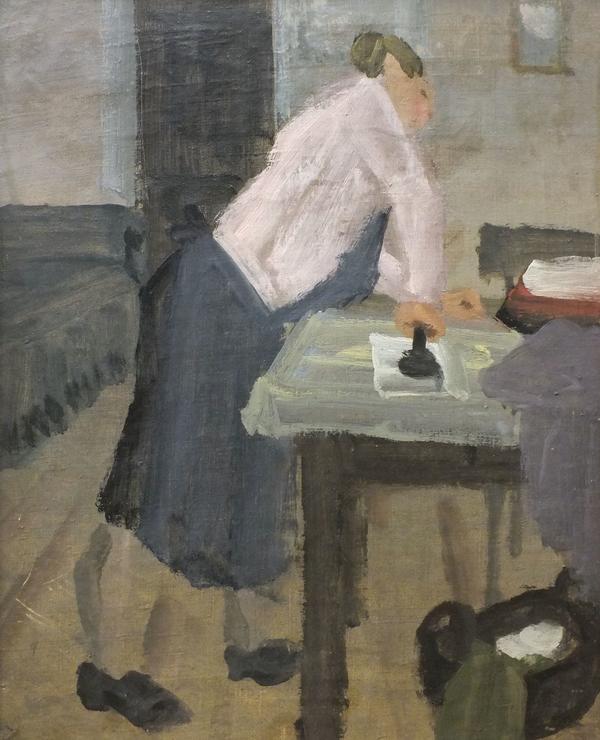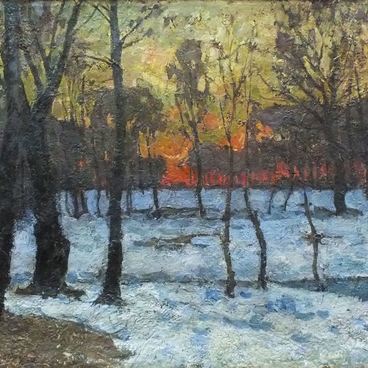The painter, graphic artist and teacher Vladimir Greenberg is known as a representative of the ‘Leningrad landscape school’, which also included Alexander Vedernikov, Nikolai Lapshin, Nikolai Tyrsa and a number of other artists. Distinctive features of the school were connection with the Primitive art and aesthetical stylization of the image.
In Vladimir Greenberg’s painting Woman Ironing we see a ruddy woman in a pink sweater busy with one of the most trivial housework chore. She’s got a cast iron in her hand, and her body expresses distinct tension. The artist clearly conveyed the effort required for ironing at that time, when good result was achieved by applying the whole weight of the human body. The canvas itself is done in the manner typical of the mature period of the painter’s artwork: a limited range of colors, schematization of in depicting figures and objects.
Vladimir Greenberg was born in 1896 in Rostov-on-Don. He got interested in the visual arts in high school. After graduating from the Rostov Commercial School with a gold medal, Greenberg went to Petrograd, where he passed the entrance exams to the Academy of Arts but was not enrolled because of the “Jewish” quota. He entered the Polytechnic Institute and combined his studies with attending he art school of Princess Gagarina, where at the time Alexander Yakovlev and Osip Braz taught.
During the difficult post-revolutionary period, Vladimir Greenberg returns to Rostov-on-Don, where he teaches and works as an artist of Political Prosperity in the North Caucasus Military District until 1922. During this period, he produces a series of portraits of members of the Revolutionary Military Council, including portraits of Semen Budyonny and Kliment Voroshilov.
At first, the artist was close to the ideas of the revolution. In 1922, Vladimir Greenberg returns to Petrograd and starts working as a book and magazine graphic artist. During this period of his work, in addition to portraits and landscapes, he also turned to the household genre and worked in various techniques — pencil, coal, sanguine and watercolors. His works were exhibited in the USA, Japan, France and Italy from 1924 to 1927.
Since the 1930s, Vladimir Greenberg starts gradually breaking away from academic realism. He gives up on the earlier tendency to detail faces and objects. For landscapes he employs the pastose painting, which was characteristic of post-impressionist school, whereas the light shades and linear perspective disappear. In the portraits Greenberg resorts to a flat, concise manner, wide brushstroke, simplification of forms and a deliberate incompleteness, giving his paintings sense of special dynamics.
Despite accusations of “formalism”, which forced him to leave teaching at the Leningrad Institute of Painting, Sculpture and Architecture, critics highly appreciated the work of Vladimir Greenberg. He was called a master “with a huge range”, and his artwork was defined as “something precious to our culture, on which we can truly rely''.
In Vladimir Greenberg’s painting Woman Ironing we see a ruddy woman in a pink sweater busy with one of the most trivial housework chore. She’s got a cast iron in her hand, and her body expresses distinct tension. The artist clearly conveyed the effort required for ironing at that time, when good result was achieved by applying the whole weight of the human body. The canvas itself is done in the manner typical of the mature period of the painter’s artwork: a limited range of colors, schematization of in depicting figures and objects.
Vladimir Greenberg was born in 1896 in Rostov-on-Don. He got interested in the visual arts in high school. After graduating from the Rostov Commercial School with a gold medal, Greenberg went to Petrograd, where he passed the entrance exams to the Academy of Arts but was not enrolled because of the “Jewish” quota. He entered the Polytechnic Institute and combined his studies with attending he art school of Princess Gagarina, where at the time Alexander Yakovlev and Osip Braz taught.
During the difficult post-revolutionary period, Vladimir Greenberg returns to Rostov-on-Don, where he teaches and works as an artist of Political Prosperity in the North Caucasus Military District until 1922. During this period, he produces a series of portraits of members of the Revolutionary Military Council, including portraits of Semen Budyonny and Kliment Voroshilov.
At first, the artist was close to the ideas of the revolution. In 1922, Vladimir Greenberg returns to Petrograd and starts working as a book and magazine graphic artist. During this period of his work, in addition to portraits and landscapes, he also turned to the household genre and worked in various techniques — pencil, coal, sanguine and watercolors. His works were exhibited in the USA, Japan, France and Italy from 1924 to 1927.
Since the 1930s, Vladimir Greenberg starts gradually breaking away from academic realism. He gives up on the earlier tendency to detail faces and objects. For landscapes he employs the pastose painting, which was characteristic of post-impressionist school, whereas the light shades and linear perspective disappear. In the portraits Greenberg resorts to a flat, concise manner, wide brushstroke, simplification of forms and a deliberate incompleteness, giving his paintings sense of special dynamics.
Despite accusations of “formalism”, which forced him to leave teaching at the Leningrad Institute of Painting, Sculpture and Architecture, critics highly appreciated the work of Vladimir Greenberg. He was called a master “with a huge range”, and his artwork was defined as “something precious to our culture, on which we can truly rely''.



